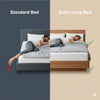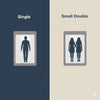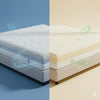How to Style Your Bedroom Around a Statement High Headboard
- by Giorgi Gogidze

A statement high headboard can transform your bedroom from ordinary to extraordinary, serving as both a functional piece and a dramatic focal point. When done right, a towering headboard creates visual impact, adds architectural interest, and establishes the design foundation for your entire bedroom. However, styling around such a prominent feature requires careful consideration of proportions, color harmony, and complementary elements.
[toc]
Whether you've already invested in a show-stopping headboard or you're planning to make this bold design choice, this comprehensive guide will help you create a cohesive, stylish bedroom that celebrates your statement piece while maintaining balance and functionality.
Understanding the Power of a Statement High Headboard
A high headboard typically extends 48 inches or more above the mattress, creating a dramatic vertical element that draws the eye upward and makes ceilings appear higher. Unlike standard headboards that hover just above pillows, statement high headboards command attention and establish themselves as the room's primary design feature.
The key to successful styling lies in treating your headboard as the star of the show while ensuring every other element supports and enhances its impact. This means considering how colors, textures, lighting, and furniture placement all work together to create a harmonious yet striking bedroom design.
Choosing Your Design Direction
Before selecting complementary elements, establish the design story you want your headboard to tell. Your styling approach will vary significantly depending on whether your headboard embodies modern minimalism, traditional elegance, bohemian eclecticism, or industrial edge.
Modern and Contemporary High Headboards Sleek, geometric high headboards in neutral tones or bold solid colors work beautifully in contemporary settings. These often feature clean lines, minimal ornamentation, and sophisticated materials like leather, linen, or architectural elements. The styling approach should emphasize simplicity and sophistication.
Traditional and Ornate High Headboards Elaborately carved wooden headboards, tufted velvet designs, or those with intricate metalwork require a more classical styling approach. These headboards often feature rich materials and detailed craftsmanship that should be honored with complementary traditional elements.
Bohemian and Eclectic High Headboards Rattan, macramé, or globally-inspired high headboards thrive in eclectic settings where layered textures, warm colors, and collected objects create visual interest. The styling here can be more relaxed and layered.
Industrial and Raw High Headboards Metal, reclaimed wood, or concrete high headboards work well in industrial or urban settings. These typically pair with raw materials, neutral color palettes, and functional design elements.
Color Coordination Strategies
A statement high headboard significantly influences your bedroom's color scheme, and your approach will depend on whether your headboard is neutral or boldly colored.
Working with Neutral High Headboards Neutral headboards in shades of white, beige, gray, or natural wood provide flexibility in your color choices. You can either maintain a monochromatic scheme for sophisticated elegance or use the neutral headboard as a backdrop for bold accent colors in bedding, artwork, and accessories.
For a cohesive monochromatic look, layer different shades and textures of your chosen neutral. A cream linen headboard might be paired with ivory bedding, taupe throw pillows, and warm white walls, with interest created through varying textures rather than contrasting colors.
Alternatively, use your neutral headboard as an anchor for a more colorful scheme. A charcoal gray headboard provides an excellent backdrop for jewel tones like emerald green or sapphire blue, while a natural wood headboard complements warm colors like terracotta or mustard yellow.
Styling Bold Colored High Headboards When your headboard makes a strong color statement, the rest of the room should provide balance rather than competition. A deep navy velvet headboard might be complemented by soft whites and warm metallics, allowing the headboard to remain the focal point while creating a sophisticated, hotel-like atmosphere.
The key is to repeat your headboard color subtly throughout the room through smaller accessories like throw pillows, artwork, or a single accent piece. This creates visual coherence without overwhelming the space.
Creating Contrast and Drama Sometimes the most striking bedrooms feature deliberate contrast between the headboard and surrounding elements. A stark white architectural headboard against dark walls creates modern drama, while a rich burgundy headboard against soft gray walls provides sophisticated contrast.
Furniture Placement and Proportion
A high headboard affects how you arrange other bedroom furniture, both for aesthetic balance and practical functionality.
Nightstand Considerations With a towering headboard, your nightstands should provide visual weight without competing for attention. Choose nightstands that are roughly one-third to one-half the height of your headboard for pleasing proportions. If your headboard extends 60 inches above the mattress, nightstands between 24-30 inches tall will look balanced.
Consider the width as well. Nightstands should be wide enough to be functional but not so wide that they overwhelm the space or make the headboard appear narrow by comparison.
Dresser and Storage Placement Position larger furniture pieces like dressers where they won't compete with your headboard's visual impact. Often this means placing them on walls perpendicular to the bed rather than directly across from it. This arrangement also helps maintain the headboard as the room's primary focal point.
Seating Areas If space allows, a seating area at the foot of the bed or in a corner can balance the visual weight of a high headboard. A bench, chair, or small settee provides both functionality and helps ground the room's proportions.
Lighting Design for High Headboards
Proper lighting enhances your statement headboard while providing practical illumination for bedroom activities.
Accent Lighting for Drama Consider uplighting or wall sconces that highlight your headboard's texture and materials. LED strip lighting behind a headboard can create a dramatic halo effect, especially effective with headboards that have some separation from the wall.
Bedside Lighting Solutions With a high headboard, traditional bedside table lamps might appear dwarfed. Consider wall-mounted swing-arm sconces that free up nightstand space while providing adequate reading light. These should be positioned to complement your headboard's lines rather than compete with them.
Overhead and Ambient Lighting A statement ceiling fixture can work harmoniously with a high headboard, especially if both share similar design elements or materials. However, ensure the ceiling fixture doesn't visually clash with your headboard's lines or create awkward sight lines when you're in bed.
Wall Treatment and Backdrop Creation
The wall behind and around your high headboard requires careful consideration to ensure your statement piece has the perfect backdrop.
Paint Color Choices The wall color behind your headboard can either make it pop with contrast or blend harmoniously for a more subtle effect. A light-colored headboard against a darker wall creates drama and definition, while a headboard in a similar tone to the wall creates a more integrated, architectural look.
Wallpaper and Textural Elements If using wallpaper, choose patterns that complement rather than compete with your headboard. Generally, if your headboard is ornate or textured, keep wall treatments simple. Conversely, a simple headboard can handle more elaborate wall treatments.
Architectural Elements Consider adding architectural interest through board and batten wainscoting, picture frame molding, or other millwork that complements your headboard's style. These elements should enhance rather than overshadow your statement piece.
Bedding and Textile Coordination
Your bedding choices significantly impact how your high headboard is perceived and appreciated.
Layering for Visual Interest With a statement headboard, your bedding can be more understated, allowing the headboard to shine. However, thoughtful layering of textures and complementary colors creates depth and visual interest. Consider how different textile textures play against your headboard material.
Pillow Arrangements High headboards provide an excellent backdrop for creative pillow arrangements. You can use more pillows than you might with a standard headboard, creating layers that complement the headboard's height. Mix sizes, textures, and patterns while maintaining color harmony.
Throw and Blanket Styling A carefully chosen throw at the foot of the bed or draped over a corner can tie your color scheme together while adding textural interest that complements your headboard's material.
Artwork and Wall Décor Strategy
Decorating walls around a statement high headboard requires restraint and strategic thinking.
The Art Placement Dilemma Traditional advice suggests hanging artwork above headboards, but with a high headboard, this often creates awkward proportions and uncomfortable viewing angles. Instead, consider flanking your headboard with artwork or creating gallery walls on adjacent walls.
Scale and Proportion in Art Selection When you do include artwork in the same visual field as your headboard, ensure pieces are substantial enough to hold their own. Small artwork can appear insignificant next to a commanding headboard.
Alternative Décor Solutions Consider sculptural elements, large mirrors on adjacent walls, or architectural features that complement your headboard without directly competing with it.
Creating Balance with Accessories
Accessories should support your headboard's impact while adding personality and functionality to your bedroom.
Strategic Accessory Placement Place accessories where they'll be noticed but won't compete with your headboard. Nightstand styling becomes more important as these surfaces are at eye level when you're in bed and provide opportunities to echo colors and textures from your headboard.
Scale Considerations Choose accessories that are proportionate to your room's new scale with the high headboard. Tiny objects may appear lost, while appropriately sized pieces help maintain visual balance.
Metallic Accents and Hardware If your headboard features metal elements or hardware, echo these materials in your accessories, lighting fixtures, or furniture hardware to create cohesion throughout the room.
Window Treatments and Their Relationship to High Headboards
Window treatments take on new importance when you have a statement high headboard, as both are significant vertical elements in your room.
Height and Proportion Coordination Your window treatments should complement rather than compete with your headboard's height. This might mean extending curtains to the ceiling to match your headboard's dramatic vertical lines, or choosing treatments that provide horizontal balance to offset the headboard's height.
Color and Material Harmony Consider how your window treatment materials and colors relate to your headboard. They should feel like part of the same design story rather than conflicting elements.
Common Styling Mistakes to Avoid
Learning from common pitfalls can help you achieve the sophisticated look you're after.
Overcrowding the Space A statement high headboard already provides significant visual weight. Avoid adding too many competing elements that could make the room feel cluttered or chaotic.
Ignoring Ceiling Height Ensure your headboard height is appropriate for your ceiling height. A room with 8-foot ceilings might feel cramped with a 6-foot headboard, while a room with 12-foot ceilings can easily accommodate dramatic height.
Mismatched Proportions All elements in your room should relate harmoniously to your headboard's scale. Tiny nightstands, undersized artwork, or inappropriately scaled lighting can throw off the entire room's balance.
Competing Focal Points With a statement headboard as your room's star, other elements should play supporting roles. Avoid creating additional focal points that divide attention.
Seasonal and Long-term Adaptability
A statement high headboard is typically a long-term investment, so consider how you can adapt your styling over time.
Flexible Color Schemes Choose foundational colors that allow for seasonal changes through easily replaced elements like throw pillows, artwork, and accessories.
Timeless vs. Trendy Elements While your headboard makes a bold statement, ensure your supporting elements have staying power. Invest in quality pieces that won't look dated quickly.
Future-Proofing Your Design Consider how your styling choices will adapt as your needs change or as design trends evolve. Neutral foundations with changeable accents provide the most flexibility.
Bringing It All Together
Successfully styling around a statement high headboard requires treating it as the foundation of your bedroom design while carefully orchestrating every other element to support and enhance its impact. The result should feel intentional, balanced, and harmonious rather than dominated by a single oversized element.
Remember that the best bedroom designs feel collected over time rather than purchased all at once. Start with your statement headboard and build your design gradually, paying attention to how each new element relates to both the headboard and the overall composition.
Your statement high headboard has the power to transform your bedroom into a space that feels both dramatic and deeply personal. With thoughtful styling that respects proportions, embraces harmony, and celebrates your headboard's unique character, you'll create a bedroom that feels like a luxurious retreat designed specifically for you.
The key is confidence in your choices and patience in the styling process. When done thoughtfully, a bedroom styled around a statement high headboard becomes more than just a place to sleep—it becomes a masterpiece of personal design that reflects your style and creates the perfect backdrop for rest and rejuvenation.




